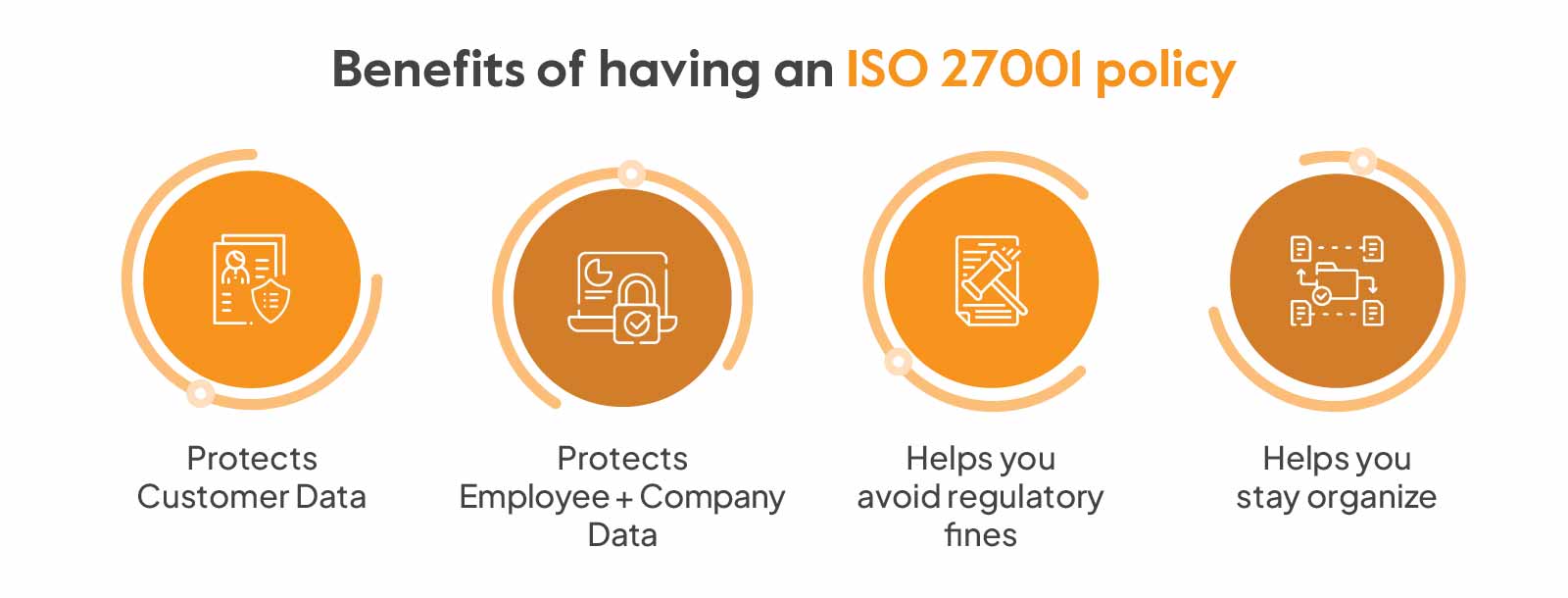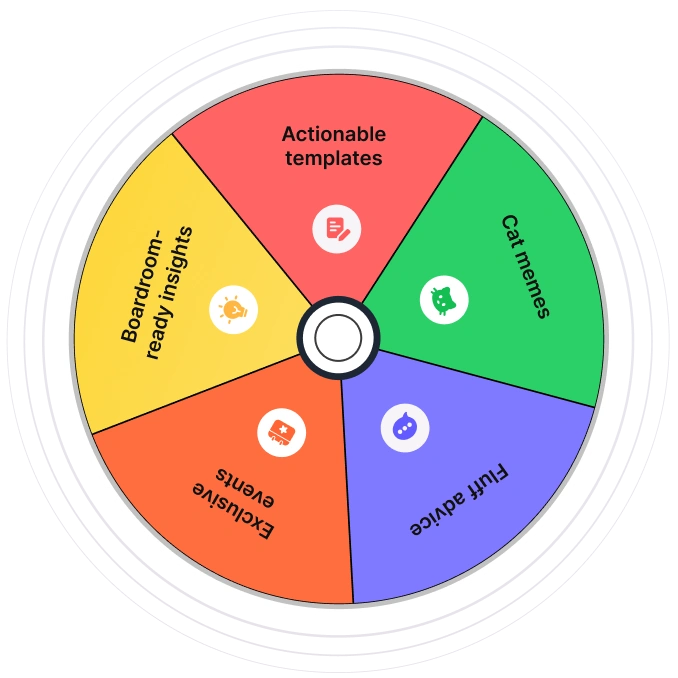Implementing ISO 27001 can feel like staring at a blank page with a looming deadline. Defining security controls, documenting your policies, and identifying gaps are challenging, especially without a clear starting point. You need structure, consistency, and airtight documentation – winging is not an option for audit-readiness.
That’s where ISO 27001 policy templates come in. These give you the framework, language, and structure to move fast without missing the essentials. In this blog, we will outline the steps for creating an ISO 27001 policy and discuss what a template should include.
- ISO 27001 policies help organizations manage risk, define security practices, and align with compliance requirements.
- It includes key sections like purpose, scope, roles, risk management, and training — all mapped to ISO 27001 clauses and Annex A controls.
- You can jumpstart compliance and reduce audit friction with this free ISO 27001 policy template
What is ISO 27001 policy?
ISO 27001 policy or policies refer to a collection of documents that outline an organization’s practices or approach to manage their sensitive information assets and minimize security risks. These policies help to establish accountability for internal teams or external vendors, help to demonstrate commitment to data security to prospects, and identify the systems or assets that fall within the scope of the ISMS.
Why should you create an ISO 27001 policy
Well, one of the most obvious and primary reasons for having an ISO 27001 policy is to protect the organization’s data from security threats. But there’s more to it. Let’s see why ISO 27001 information security policy is important to have.

- Protect Customer Data: While handling client data such as their personal information, technical information, and so on, clients expect that you have security systems in place to protect the data. The policy helps you streamline the process.
- Protect Employee + Company Data: You have the personal and financial data of your employees and also the data of your company in the databases and CRM. This is sensitive information, and ISO 27001 policy helps you keep this data safe.
- Avoid Regulatory Fines: ISO 27001 is a starting point for various security regulations such as GDPR. By having an information security policy in place, you can avoid hefty penalties for non-compliance with data protection requirements.
- Stay Organized and Focused: With proper policy documentation, employees can retain their roles and responsibilities regarding information security. The policy helps your organization stay focused on information security tasks.
What policies are mandatory for ISO 27001?
Before diving into the specifics, it’s important to recognize the role these policies play. ISO 27001 requires a structured Information Security Management System (ISMS) that protects your organization’s data assets with clear, auditable practices. The policies listed below are required by the standard and serve as the backbone of a strong compliance program. Missing any of them puts your certification at serious risk.
For a quick overview, here’s a summarized table outlining each ISO 27001 mandatory documents, its purpose, key elements, and the corresponding clause or annex. You’ll find a detailed explanation of each policy below.
| Policy | Purpose | Key Elements | ISO Clause / Annex |
| Information Security Policy | Defines ISMS direction and leadership commitment | Roles and responsibilities, legal obligations, security objectives | Clause 5.2 |
| Access Control Policy | Restricts data access based on user roles | Access provisioning, revocation, special privileges | Annex A.9 |
| Risk Assessment & Treatment Policy | Identifies and mitigates risks to ISMS | Risk scoring, treatment plans, gap analysis | Clause 6.1 |
| Third-Party Risk Management Policy | Manages vendor-related risks | Onboarding process, activity monitoring, evaluation strategy | Annex A.15 |
| Business Continuity & Disaster Recovery | Ensures rapid recovery post-incident | Recovery steps, roles, impact analysis | Annex A.17 |
| Security Awareness & Training Policy | Educates employees and vendors | Training programs, frequency, breach reporting | Annex A.7.2.2 |
| Remote Working Policy | Secures off-premise device usage | Encryption, password policies, malware protection | Annex A.6.2.1 |
| Data Backup & Restore Policy | Protects against data loss and ransomware | Backup frequency, storage, responsible personnel | Annex A.12.3 |
| Logging & Monitoring Policy | Tracks and investigates security events | What to log, alert mechanisms, change detection | Annex A.12.4 |
| Malware & Antivirus Policy | Prevents infection and damage from malicious software | Approved tools, update cycles, response process | Annex A.12.2 |
1. Information security policies
These are the centerpieces that hold your controls, measures, and practices together. It is a high level, umbrella policy that sets forth the groundwork, foundation, and direction for your ISMS. Activities related to leadership commitment, employee level roles and responsibilities, legal obligations, and basic security objectives are generally specified in this policy.
As per ISO 27001 clause 5.2, information security policy is mandatory to demonstrate top management’s involvement.
2. Access control policy
As the number of roles in an organization grows, each role must be correctly connected to the complex network of systems and applications. Everyone accessing every data is a security disaster waiting to happen.
An access control policy ensures that individuals can view, edit, or share only those resources specific to their functions. It aims to prevent unauthorized roles from accessing sensitive files. The policy covers aspects like new registration, rules to grant access request, access revoke, and special privileges.
3. Risk assessment and mitigation
Clause 6.1 of ISO 27001, concerned with risk management is mandatory and critical to maintain ISMS health. It underscores the importance of proactively managing risks rather than adopting a reactive approach.
The risk assessment policy should outline how you manage risk throughout its lifecycle, including identification plans, risk appetite definition, scoring processes, treatment plans, and gap analysis plans.
4. Third party risk management policy
Outsourcing certain activities saves time and cuts costs. However, external users accessing internal systems add unprecedented risks like data loss and accidental exposure, necessitating the need to implement security guardrails.
Your TPRM policy should outline the process for securely onboarding new vendors, securely onboarding existing vendors, plans to monitor third party activities, mitigating risks associated with them, and vendor evaluation strategies.
5. Disaster management and business continuity
Annex A.17 aims to minimize operational disruptions caused by breach events. A disaster management and business continuity policy helps to restore critical functions to normal after an incident.
This policy should outline the immediate steps to restore systems, roles responsible for each step, remediation plan, impact analysis, and steps to prevent similar incidents in the future.
6. Security awareness and training policy
Employees are the first line of defense against security risks. In order to protect information systems, they should be well versed with the hows and whats.
Security awareness and training policies apply not just to employees, but external vendors and consultants as well – essentially anyone accessing your information systems.
The policy should mention staff responsibilities, list of training programs, frequency of conducting training sessions, how to report and respond to breaches.
7. Remote working policy
When employees use organization administered devices outside its secure perimeter, it exposes them to an unprecedented number of vulnerabilities.
A remote working policy helps to minimize data breaches, prevent unauthorized access, and reduce risks like accidental data exposure to unauthorized users.
Your remote working policy should outline malware detection system installation, encryption plans, device password policies, and employee training schedules.
8. Data backup and restore policy
Data breaches like ransomware attacks halt critical operations, product launch delays, and expose sensitive data to unauthorized users. These can be minimized by developing and implementing a data backup and restore policy.
Include what data to backup, systems where it will be stored, frequency for backing up, users responsible for this activity, and security controls used to protect the backed up data.
9. Logging and monitoring policy
Insider threats contribute to a significant percentage of risks in organizations. Audit logging and monitoring help to investigate incidents by retracing the steps that led to a breach – description of the event, timesnaps, the user responsible for it, the location, and the device from which it happened.
A comprehensive log and monitoring policy includes what events to log or monitor, storage facilities to maintain a database, alerting and notification process for suspicious activities, and change detection mechanisms.
10. Malware and antivirus policy
Cloud hosted assets and applications are prone to a wide range of risks and security threats. Installing antivirus and malware detection tools are basic hygiene practices that prevent vulnerabilities from escalating into issues.
Your policy should detail the approved set of tools, such as EDRs or XDRs, who is responsible for updating them, the incident response process, and how the policy will be reviewed in the event of an incident.
What Does an ISO 27001 Policy Template Include?
Often businesses believe that their ISO 27001 information security policy needs to have everything about the organization’s security posture. However, this is not the intent of the information security policy template. On a high level, your ISO policy template should cover these sections:

- Purpose: Explain why the policy exists; the purpose you wish to achieve. For example, “to safeguard the confidentiality, integrity, and availability of information.”
- Scope: Define which parts of the organization, systems, and data are covered. This helps to minimize ambiguity and ensure transparency.
- Roles and responsibilities: Define who the policy applies to; IT teams, risk managers, compliance officers, management, and so on. This is critical to ensure accountability.
- Risk management: Here you outline your plan to identify, assess, and mitigate risks. Given that ISO 27001 is centered around risk management, this is a critical component.
- Awareness and training: Helps to ensure that your employees and external stakeholders know their roles, do not engage in risky activities, and takes the right course of action if a breach occurs.
- Exceptions: Mention the edge cases when and where certain rules may not apply. Define how these expectations are managed and handled.
- Support: This section defines the resources and supplemental policies that will be helpful for the ISO 27001 auditors.
How to create ISO 27001 policy and implement it?
Implementing ISO policies requires time and commitment. If you are doing this for the first time, follow these simple steps:
Step 1: Understand how the standard applies to your business
One common myth associated with ISO 27001 certification is that you have to implement every control listed under Annex A. This misconception stems from the fact that these controls are viewed as a checklist, rather than a guide.
Before developing your policies, conduct a risk assessment to evaluate which controls and measures apply to your business. Given that writing policies is a tedious task, doing this will save you time and effort.
Step 2: Develop a policy framework
Given that this project involves developing multiple ISO 27001 policy documents, categorize the policies based on the result of risk assessment, identified controls, and scope of these policies.
Next, align each policy to its relevant ISO clauses and Annex A controls. Use this map as reference:
| Policy | Relevant ISO Clauses | Annex A Controls |
| Information security policy | 5.2, 5.3, 6.2 | A.5.1 (Policies for Information Security) |
| Access control policy | 6.1.3, 8.1 | A.8.2 (Identity Management), A.8.3 (Access) |
| Risk assessment & treatment | 6.1.2, 6.1.3 | A.5.4 (Risk Management Framework) |
| Asset management policy | 7.5, 8.1 | A.5.9–A.5.12 (Asset Management) |
| Incident management policy | 6.1, 8.1, 10.1 | A.5.22–A.5.24 (Incident Mgmt) |
| TPRM Policy | 6.1, 8.1 | A.5.19–A.5.21 (Supplier Relationships) |
| Business continuity policy | 6.1, 9.1 | A.5.29–A.5.31 (BCP & Disaster Recovery) |
| Logging & monitoring policy | 9.1, 10.1 | A.8.15 (Logging), A.8.16 (Monitoring) |
Step 3: Communicate and conduct training
Policies are effective only when the involved stakeholders know the hows and whens of each document. Communicate the details of your ISO 27001 information security policy with employees, consultants, and third party vendors. Ensure they understand their roles, the importance of each policy in getting certified, and how to implement them. Get a sign off from the involved parties to ensure accountability and maintain transparency.
Step 4: Integrate into daily operations
Developing policies is useful only when implemented into actual use cases. Map each policy to specific operations. For example, if your access control policy includes a clause to review all user access on a quarterly basis, set up a workflow in your IAM tool to automatically review access for users.
You can use this sample table to tie in policies with workflows.
| Policy | Control | Tool |
| Access Control | Quarterly access reviews | Okta, Azure AD, SailPoint |
| Acceptable Use | Blocking USB devices | MDM tools (Intune, Jamf) |
| Incident Response | Ticketing and post-mortem workflows | JIRA, PagerDuty |
| Data Classification | Tagging and labeling of documents | Microsoft Purview |
| Supplier Security | Security due diligence checklist before onboarding | Vendor risk platforms |
Step 5: Update and review
Developing ISO policy template is not a time activity, but a continuous commitment. As more roles are added to infrastructure, ISO releases new updates, or you adopt new systems, existing policies are likely to be impacted.
To ensure you don’t fall out of compliance, set up a timeline to review and update policies as per your business requirements and regulatory changes.
Download Your ISO 27001 Information Security Policy Template
Automate Policy Management with Sprinto
Writing, updating, and managing policies manually is slow, error-prone, and drains your IT and compliance teams. Starting from scratch each time, juggling document versions, and manually assigning ownership adds unnecessary complexity and risk.
Sprinto eliminates this chaos with automated policy management. It centralizes all your policies in one dashboard, making it easy to track, update, and enforce compliance across the organization.
Here’s how Sprinto simplifies policy management at every stage:
- Automated Templates – Sprinto provides ready-to-use, auditor-approved policy templates aligned with ISO 27001 and other frameworks. You skip the blank page and jump straight to implementation.
- Unified Dashboard – Track every policy, its status, owner, and version history from one central location. No more toggling between spreadsheets, folders, or tools.
- 1-Click Attestation – Employees and vendors can instantly acknowledge policies with a single click. Sprinto handles follow-ups and escalations automatically, ensuring full coverage.
- Framework Mapping – Each policy is auto-mapped to ISO 27001 clauses and Annex A controls. This eliminates guesswork and ensures you’re always aligned with compliance requirements.
- Hands-Free Ops – Automate ownership tracking, version control, policy renewals, and communication flows. Sprinto takes care of the repetitive admin work so your team doesn’t have to.
- Always Audit-Ready – Real-time alerts on compliance drift and a dedicated auditor dashboard ensure you’re never caught off guard. Evidence collection and policy links are audit-optimized by default.
- Scale Without Headcount – Whether you’re a 10-person startup or scaling globally, Sprinto automates policy workflows end-to-end. You won’t need to expand your team just to stay compliant.
See Sprinto in action. Talk to our experts now.
FAQs
Yes, having a statement from higher management, such as the CEO or CTO, is a good and confident approach to record leadership commitment.
Yes, companies from different industries can use the template as a base to customize and develop the ISO 27001 policy as per their goals and requirements.
Yes, as per Annex A.5.1.1, organizations must have an information security policy, and the stakeholders must be informed of all the policies in place.
ISO 27001 requires organizations to define and maintain several information security policies aligned with its clauses and Annex A controls. Core ones include the Information Security Policy, Access Control, Risk Assessment and Treatment, Incident Management, Business Continuity, Supplier Security, Cryptographic Policy, and others. The number of policies are mostly around 12–20 in total depending on your scope and risks.
Yes you can definitely use templates to speed up ISO 27001 readiness, especially if you have a startup or teams new to compliance. Just make sure you tailor them to your actual processes and risks.
You can find free ISO 27001 policy templates from sources like Advisera, ISO27001Security.com, IT Governance UK, and even GitHub. If you’re using Sprinto or another GRC tool, many pre-vetted templates are already included and customizable to your needs.
Payal Wadhwa
Payal is your friendly neighborhood compliance whiz who is also ISC2 certified! She turns perplexing compliance lingo into actionable advice about keeping your digital business safe and savvy. When she isn’t saving virtual worlds, she’s penning down poetic musings or lighting up local open mics. Cyber savvy by day, poet by night!
Explore more ISO 27001 articles
ISO 27001 Overview & Requirements
ISO 27001 vs Other Frameworks
ISO 27001 Audit & Certification Process
ISO 27001 Management & Assessment
ISO 27001 Implementation & Automation
ISO 27001 Industry-Specific Applications
research & insights curated to help you earn a seat at the table.








